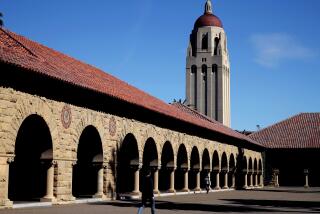December’s Gift to O.C.: Just 2% Out of Work
- Share via
Orange County’s jobless rate fell to a historic low of 2% last month, state officials said Friday, providing strong evidence the local labor market remains vigorous despite an emerging economic slowdown.
“That’s a real record for us, going back all the way to the 1940s,” said Ann Marshall, the Employment Development Department’s labor market analyst in Orange County. “The size of our labor force has peaked,” she added, referring to the more than 1.5 million residents in the county who held jobs last month.
Statewide, the unemployment rate also dropped in December, to a seasonally adjusted rate of 4.6%. Despite the energy crunch and an economic slowdown nationally on a variety of fronts, California added a surprisingly strong 53,100 payroll jobs.
The decline in joblessness, down from 4.8% in November, brought the unemployment rate to the lowest level of the state’s 7 1/2-year expansion and equaled a 30-year low for California. For African-Americans, joblessness also fell to a record low.
What’s more, all five Los Angeles-area counties except Ventura reported their best monthly unemployment rates since state officials started keeping local jobless statistics in their current form in the early 1980s. Orange County’s unemployment dropped from 2.3% in November.
In one of the clearest indications of where California stands versus the rest of the country, the state accounted for more than half of the 105,000 jobs added across the country last month.
The strong job numbers could be partly the result of “labor hoarding,” companies tending to hold onto skilled and hard-to-find workers even when the economy begins to show signs of softening, said Radha Battacharya, an economics professor at Cal State Fullerton.
“It could be because they are afraid they will lose these workers and it will be costly to recruit new workers later,” she said. “You do not see companies firing their skilled labor right away. They’ll wait.”
Friday’s employment report, although better than expected, squared with recent assessments by many leading business forecasters that the national downturn is only starting to touch California. Some economists said December could prove to be the last big hurrah before California’s energy troubles, along with reduced technology spending and other potential hazards, start translating into higher unemployment and slower job growth.
“2000 was a very good year for the California economy. There’s no two ways about that. But we’re going to see some moderation of growth in 2001, that’s also fairly clear,” said Ted Gibson, chief economist for the California Department of Finance.
In fact, even in the buoyant employment report for last month, there were a few signs of weakness. The most notable soft spot in December was manufacturing, which lost 2,200 jobs.
Analysts also said that a big gain in construction employment stemmed largely from the unusually dry weather last month, and is likely to be washed out by January’s heavy rains. Likewise, the strong job increases in motion pictures mainly resulted from the rush to finish projects before the anticipated midyear strikes in Hollywood, which could bring severe economic repercussions later on.
Forecasters in recent weeks have said the state’s outlook for this year also is clouded by high natural gas prices and California’s overburdened power grid, which could lead to rolling blackouts and soaring bills. In Southern California industries such as textiles, the energy squeeze already has prompted production cutbacks.
Layoffs have begun to hit Orange County as well. Companies such as high-technology incubator Odetics Inc. in Anaheim and Gateway Inc., a San Diego-based personal computer maker with about 800 workers in Orange County, have announced layoffs in recent days.
Still, analysts said the December jobs report shows how much steam remains in the local economic engine. “It is indicative of a very, very strong economy,” said Esmael Adibi, director of the Center for Economic Research at Chapman University.
He said, however, that monthly unemployment rates should start edging up early this year, since rates are typically lowest in December because of the seasonal and part-time jobs. Unlike California’s jobless figure, those for counties like Orange are not seasonally adjusted.
Overall, Adibi still expects Orange County to add more jobs in 2001 than last year, partly because of Walt Disney Co.’s expansion in Anaheim. “In spite of all the doom and gloom, we are forecasting 48,000 jobs to be generated [in 2001],” he said, about 3,000 more than this year.
Orange County’s latest unemployment rate did not surprise Peter Margarita, vice president of West Coast operations for Snelling Personnel Services. Job orders are continuing to pour in at his Costa Mesa office, many of them from high-tech companies.
“Even though some of the dot-com companies are not doing well or have gone out of business . . . the economy still seems to be rolling along very similarly to last year,” Margarita said. “In general, we still have more orders than we have people to fill those orders, especially in the technical area. Despite what you hear about the technology businesses, they’re still growing, they still need people.”
The personnel supply industry remains one of the strongest job producers in Orange County. That industry is part of the business services category, which also includes software firms. As a whole, business services has added 8,200 jobs over the last year--a 6% growth rate, double the countywide pace for all industries.
For the year, construction employment in Orange County led the way, growing by a hefty 6.5%, thanks to home building, roadwork and the massive Disneyland Resort expansion. And in contrast to the statewide and national performance, manufacturing in Orange County continues to expand, albeit at a slightly slower pace than most industries.
Statewide, December’s figures capped an extraordinary year in which California--hit harder than much of the rest of the nation by the early 1990s recession--continued to catch up fast.
For Los Angeles County, December’s jobless rate was 5%, the lowest since at least January 1983. November’s rate also was initially reported as 5%, but state officials said Friday they revised the figure to 5.1%. A year ago, it was 5.7%.
Michael S. Bernick, director of the California Employment Development Department, said he sees no sign of the anticipated slowdown. “We’re out there with employers and job seekers every day, and the number of job openings for people of all skill levels is high,” said Bernick, whose agency calculates the state’s unemployment figures and operates employment offices for job hunters.
Among African-Americans, unemployment fell to 7.5% in December, the best in at least 18 years. In December, the figure was 7.6%. For Latinos, unemployment edged up to 6.5%, from a record low of 6.4% in the four previous months.
For whites, unemployment was 4.9%, unchanged from the month before, and up only slightly from the record low of 4.8% in April. In the “Asian and other” category, the level was 4.2%, down from 4.4% in November and narrowly above the record low of 4.1% in April.
Over the full year, the latest figures show the state gained 443,100 jobs, an average of 36,925 a month. That’s the second-highest for the current expansion but analysts say that when the major annual revision in the state’s employment statistics comes out next month, 2000 could prove to be the biggest year on record for job growth. The record is 1984’s gain of 478,500.
The overall job growth in California, however, papers over some continuing problems. For instance, even as California’s urban areas added thousands of jobs, the state’s rural areas are enduring some of the worst unemployment in the country. For instance, in December Colusa County, northwest of Sacramento, had unemployment of 23.5%. The next-worst was Imperial County, east of San Diego, where unemployment stood at 21.7%.
In addition, the state suffers more than other parts of the country from an urban income gap between its wealthy elite and its lowest wage-earners, many of them immigrants. Critics say the state’s education and job-training systems will need to be overhauled for California to ever significantly lift the fortunes of its poorest residents.
In other Southern California counties, the jobless rates were as follows:
Riverside County, 4.4% last month, down from 5.1% in November and 4.5% in December, 1999.
San Bernardino County, 3.7% last month, down from 4.3% in November and 3.8% a year earlier.
San Diego, 2.3%, down from 2.7% in November and from 2.5% in December, 1999.
Ventura County, 4.1%, down from 4.7% in November and from 4.3% in December, 1999. Ventura’s record low jobless rate is 3.9%, which was last reached in March, 1989.
The figures for California and Los Angeles County are seasonally adjusted, meaning that they are recalculated to filter out the impact of traditional seasonal trends such as the heavy retail hiring in November and December. The figures for other areas in the state are not adjusted.
(BEGIN TEXT OF INFOBOX / INFOGRAPHIC)
Plenty of Work Orange County’s unemployment rate, which is not seasonally adjusted, declined to 2.0% in December, its lowest level ever. The monthly trend.
December 1999: 2.2%
December 2000: 2.0%
Source: Employment Development Department
More to Read
Sign up for Essential California
The most important California stories and recommendations in your inbox every morning.
You may occasionally receive promotional content from the Los Angeles Times.










